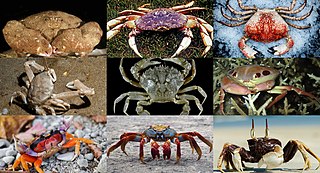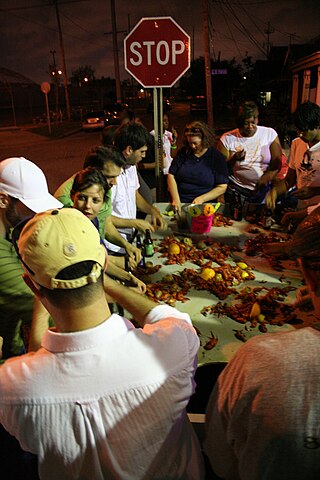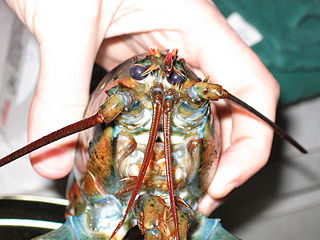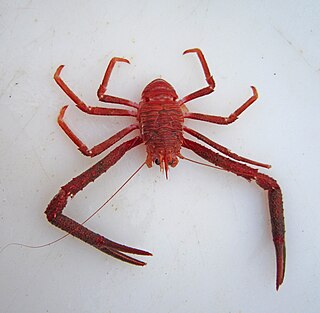Related Research Articles

Lobsters are malacostracans of the family Nephropidae. They have long bodies with muscular tails and live in crevices or burrows on the sea floor. Three of their five pairs of legs have claws, including the first pair, which are usually much larger than the others. Highly prized as seafood, lobsters are economically important and are often one of the most profitable commodities in the coastal areas they populate.

Shellfish is a colloquial and fisheries term for exoskeleton-bearing aquatic invertebrates used as food, including various species of molluscs, crustaceans, and echinoderms. Although most kinds of shellfish are harvested from saltwater environments, some are found in freshwater. In addition, a few species of land crabs are eaten, for example Cardisoma guanhumi in the Caribbean. Shellfish are among the most common food allergens.

Islamic dietary laws are laws that Muslims follow in their diet. Islamic jurisprudence specifies which foods are halal and which are haram. The dietary laws are found in the Quran, the holy book of Islam, as well as in collections of traditions attributed to the Islamic prophet Muhammad.

Crabs are decapod crustaceans of the infraorder Brachyura, which typically have a very short projecting tail-like abdomen, usually hidden entirely under the thorax. They live in all the world's oceans, in freshwater, and on land, are generally covered with a thick exoskeleton, and have a single pair of pincers on each arm. They first appeared during the Jurassic period, around 200 million years ago.

The Dungeness crab makes up one of the most important seafood industries along the west coast of North America. Its typical range extends from Alaska's Aleutian Islands to Point Conception, near Santa Barbara, California. Dungeness typically grow 6-7 inches at their widest point and inhabit eelgrass beds and sandy bottoms. Its common name comes from the Dungeness Spit in the Strait of Juan de Fuca, Washington state, United States, which shelters a shallow bay inhabited by the crabs.

Tomalley, crab fat, or lobster paste is the soft, green substance found in the body cavity of lobsters, that fulfills the functions of both the liver and the pancreas. Tomalley corresponds to the hepatopancreas in other arthropods. It is considered a delicacy, and may be eaten alone but is often added to sauces for flavour and as a thickening agent. The term lobster paste or lobster pâté can also be used to indicate a mixture of tomalley and lobster roe. Lobster bisque, lobster stock, and lobster consommé are made using lobster bodies (heads), often including tomalley.

Stunning is the process of rendering animals immobile or unconscious, with or without killing the animal, when or immediately prior to slaughtering them for food.

Larry the Lobster was the subject of a comedy sketch by Eddie Murphy that was aired live on Saturday Night Live on April 10, 1982.

Seafood boil in the United States is the generic term for any number of types of social events in which shellfish, whether saltwater or freshwater, is the central element. Regional variations dictate the kinds of seafood, the accompaniments and side dishes, and the preparation techniques. In some cases, a boil may be sponsored by a community organization as a fund-raiser or a mixer. In this way, seafood boils are like a fish fry, barbecue, or church potluck supper. Boils are also held by individuals for their friends and family for a weekend get-together and on the holidays of Memorial Day and Independence Day. While boils and bakes are traditionally associated with coastal regions of the United States, there are exceptions.

Chilean cuisine stems mainly from the combination of traditional Spanish cuisine, Chilean Mapuche culture and local ingredients, with later important influences from other European cuisines, particularly from Germany, the United Kingdom and France. The food tradition and recipes in Chile are notable for the variety of flavours and ingredients, with the country's diverse geography and climate hosting a wide range of agricultural produce, fruits and vegetables. The long coastline and the peoples' relationship with the Pacific Ocean add an immense array of seafood to Chilean cuisine, with the country's waters home to unique species of fish, molluscs, crustaceans and algae, thanks to the oxygen-rich water carried in by the Humboldt Current. Chile is also one of the world's largest producers of wine and many Chilean recipes are enhanced and accompanied by local wines. The confection dulce de leche was invented in Chile and is one of the country's most notable contributions to world cuisine.

Fish and fish products are consumed as food all over the world. With other seafoods, they provides the world's prime source of high-quality protein; 14–16 percent of the animal protein consumed worldwide. Over one billion people rely on fish as their primary source of animal protein.
George is an American lobster owned briefly by the City Crab and Seafood restaurant in New York City. Captured in December 2008, he was released back into the wild in January 2009. George weighed 20 pounds (9.1 kg), and had an estimated age of 140 years at the time.

There is a scientific debate which questions whether crustaceans experience pain. It is a complex mental state, with a distinct perceptual quality but also associated with suffering, which is an emotional state. Because of this complexity, the presence of pain in an animal, or another human for that matter, cannot be determined unambiguously using observational methods, but the conclusion that animals experience pain is often inferred on the basis of likely presence of phenomenal consciousness which is deduced from comparative brain physiology as well as physical and behavioural reactions.
Hematodinium is a genus of dinoflagellates. Species in this genus, such as Hematodinium perezi, the type species, are internal parasites of the hemolymph of crustaceans such as the Atlantic blue crab and Norway lobster. Species in the genus are economically damaging to commercial crab fisheries, including causing bitter crab disease in the large Tanner or snow crab fisheries of the Bering Sea.

The practice of eating live seafood, such as fish, crab, oysters, baby shrimp, or baby octopus, is widespread. Oysters are typically eaten live. The view that oysters are acceptable to eat, even by strict ethical criteria, has notably been propounded in the seminal 1975 text Animal Liberation, by philosopher Peter Singer. However, subsequent editions have reversed this position. Singer has stated that he has "gone back and forth on this over the years", and as of 2010 states that "while you could give them the benefit of the doubt, you could also say that unless some new evidence of a capacity for pain emerges, the doubt is so slight that there is no good reason for avoiding eating sustainably produced oysters".

Shrimp and prawn are types of sea animals that are consumed worldwide. Although shrimp and prawns belong to different suborders of Decapoda, they are very similar in appearance and the terms are often used interchangeably in commercial farming and wild fisheries. A distinction is drawn in recent aquaculture literature, which increasingly uses the term "prawn" only for the saltwater forms of palaemonids and "shrimp" for the marine penaeids. They are the animals most commonly used and killed for food production.

Surimi is a paste made from fish or other meat. The term can also refer to a number of East Asian foods that use that paste as their primary ingredient. It is available in many shapes, forms, and textures, and is often used to mimic the texture and color of the meat of lobster, crab, grilled Japanese eel or shellfish.

Munida quadrispina is a species of squat lobster. It was originally described to science by James E. Benedict in 1902. This and other species of squat lobsters are sometimes referred to as "pinch bugs".
The 2021 North-East England shellfish die-off was a series of occasions where a mass of shellfish were found on beaches on the Durham and Yorkshire Coasts in northern England, either dead, or in stages of dying.
References
- ↑ McSmith, A. (November 21, 2009). "I'll have my lobster electrocuted, please". London: The Independent (Newspaper). Retrieved June 14, 2013.
- ↑ Baker, John R. "Experiments on the humane killing of crabs." Journal of the Marine Biological Association of the United Kingdom 34.1 (1955): 15-24.
- ↑ Griffiths, G.; White, M. "Selective Seafoods; Freshly Prepared Crabs, Lobsters and other Locally Produced Seafoods". Archived from the original on June 20, 2013. Retrieved June 14, 2013.
- ↑ Dominic Kennedy (July 26, 2014). "Crustacean liberation: chefs blanch at boiling crabs and lobsters alive" . The Times . Retrieved 25 April 2021.